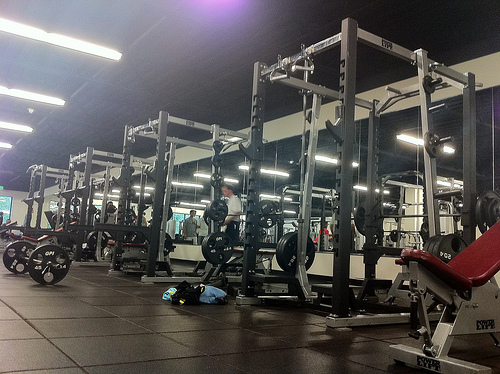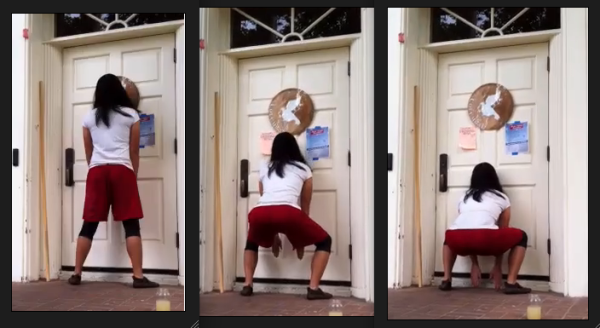Foundations for the Olympic Lift
If you’ve picked up the Fall 2010 edition of the USA Ultimate magazine / looked at p. 45 of the online edition, or have been training for more than a few months, you’ve probably heard that (learning the) Olympic lifts can Be Good For You(tm).
Why? Well, if you’re a teenager or past your twenties you might need the mass-building hypertrophy & “armor building” of bodybuilder lifts (DB curl, or generally isolated less-than-functional movements), and if you’re new to strength training, learning the powerlifts (back squat, non-trap-bar BB deadlift, bench press) is a pretty easy way to go since this is what your gym buddies probably already know, for better&worse.
[Though you might want to try a combination of front squats & RFESS over backsquats, trap-bar over non-trap-bar deadlift, and skip out on bench pressing for a while, just sayin’]
But, as Dan John reminds us, Olympic lifts have more of a cardiovascular aspect than you might expect, and the body is built as one piece, and you use it as such on the field, so why not train it that way?
So we know that you can do bodybuilder (minus the functional, multi-joint compound lifts) to build some armor and mass, and you can powerlift to develop strength, but you run the risk of developing slow-strength (F=ma) rather than explosiveness/power (force over time), and you may be adding to the imbalances in your musculoskeletal system rather than working out the weak links in your kinetic chain(s).

But let’s go back to basics. The fundamental idea behind an Olympic-style lift is that you have a weight on the ground, and you want to put it over your head. Sounds simple enough, but it’s worth re-iterating how useful it is to be able to generate enough power (force=mass x acceleration over a small time period dt) into the ground and straight up vertically. Sky that biatch anyone? Or even going old school, I’m pretty sure we humans have been picking stuff off the ground and one of the hardest things to do is to hold it overhead to throw it / move it, so we’re also probably supposed to be pretty good at that, dontcha think?
Okay, so you’re on board that it’s sweet to move weights from the floor to above your head, you like that overhead work tends to be self-limiting in a good way (see Dan John’s overhead squat article), but why BB snatch & OHS rather than KB or DB snatch / OHS? Actually I think for most athletes, learning and practicing the one-handed DB snatch is a great power exercise, and the KB snatch is hella fun (although can bang up your wrists if you start doing more than 60-70 in a row, ahem, especially your non-throwing-wrist which you’ll find probably isn’t as strong as your throwing wrist…) but learning to Olympic snatch & overhead squat your bodyweight-on-a-barbell seems like a worth goal to shoot for after you’ve been training seriously for 3-4 years.
An Olympic Progression
Building off of our previous post on strength training progressions, we’ll remind you here to first master your bodyweight, some offset-center-of-mass lifts, DB lifts, powerlifts, PVC pipe overhead squats for at least a few years before you attempt any barbell Olympic lifts.
From a joint-by-joint approach, you’re particularly going to need
= Ankle mobility
= Hip mobility
= T(horacic)-spine mobility
For the ankle, refer to previous blog posts on the ankle complex and Ultimate ankle strength.
For hip mobility, I might suggest you start with what I call the “FTW squat”. I actually stole this idea from Pavel who borrowed it from John Du Cane’s Qigong program, but they call it the Face the Wall squat which isn’t as sexay. I mean, FTW squat = squat FTW, don’t you think?
How do you squat FTW? Face-The-Wall and squat down, without bangin’ yer nose or knees into the wall. Keep on inching forward until your toes are touchin’ that wall and you descend under control, slowly, with good form.
After you squat FTW for a month+, learn to do goblet squats with a light Oly plate, 175g disc, or DB / KB.
Got that down? Now spend a couple of months learning to do an overhead staff squat. I like to call this the OHSS since I do it with a waxwood composite- staff also good for reprimanding small animals and poking medium-sized athletes, and it’s easier to find cool waxwood staffs than it is a “dowel” or “PVC pipe” (how industrial-complex of you). And anyway, who doesn’t go OHSS after trying to do a couple dozen OverHeadStaffSquats in a row?
Okay, you probably got stuck around here, since even though you worked on your ankle mobility and hip mobility for a few weeks/months, you’ve never trained mobility in your thoracic spine. You might think this is shoulder flexibility, and there’s some truth to that, but as Sue Falsone reminded us at the PerformBetter Functional Training Summit, t-spine mobility is an essential element of a strength coaching program. She actually suggested we train t-spine rotation before t-spine anterior/posterior glides/mobility, which was news to me.
So for the hardcore, try the Brettzel on for size, for everyone else, a simple t-spine twist as mentioned previously is a good start. For anterior/posterior mobility you might start with TRX assisted deep squats or goblet squats where you focus on what I call “Iron Man” chest. That is, stand or squat, and “be proud” (puff out your chest as if you’re Ahnold on some Southern California beach), or just imagine that you’re Iron Man and need to fire a beam out of your chest. The key here is you don’t want your Iron Man beam to point into the ground, you want to fire it up high at the baddies, going to a bit of extension at the t-spine and arching (not rounding!) your lumbar spine a bit.
Hey, you’ve made it this far! Maybe you’re all I can has Avatar and can pass the FMS overhead squat screen, and have spent a year or two mastering your bodyweight lifts, your Turkish get-up with small children / little women (you can do this with yer 100lb+ lady friends but it’s a bit easier to learn without pressing them overhead, just plop them on your shoulder as you punch-n-crunch in the first phase of the TGU), and have decent enough ankle dorsiflexed, hips squatty, t-spine Iron Man-ly mobility, plus enough reps with a shiny waxwood staff. What’s next?
Dan John has a great Olympic lifting program for beginners, but so far I’ve found some great work online by the legendary Tamio “Tommy” Kono.
After you watch Tommy give hands-on Olympic lifting coaching here, check out this comprehensive hour long lecture on the fundamentals of Olympic lifting (including of course the clean & jerk, which I omit in this post for simplicity), and browse through some of these non-rando articles:
…such as Beginning Olympic Weightlifting: a realistic approach or MuscleTalk- Olympic Lifting.
Or just watch H. REZAZADEH or Ingrid Marcum snatch, whatever(s) floats your boat [overhead pls].
Okay, dats it! Time to ninja up some protein-carb-oy fun and “Build the Foundations” for my own Olympic lifts.

A good DJ blog post for those coming to Olympic lifting “later” in the game (hmm, not a teenager any more?):
http://danjohn.net/2009/11/olympic-lifting-for-the-master-athlete/
but also good notes/thoughts for all aspiring Olympic lifters =)